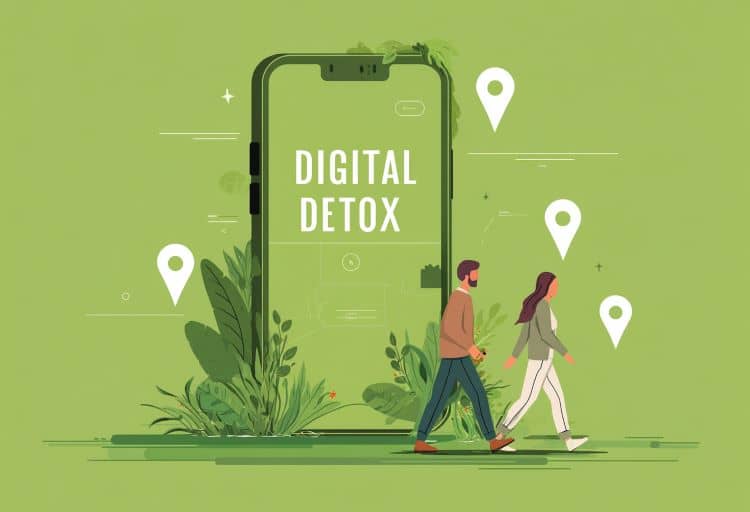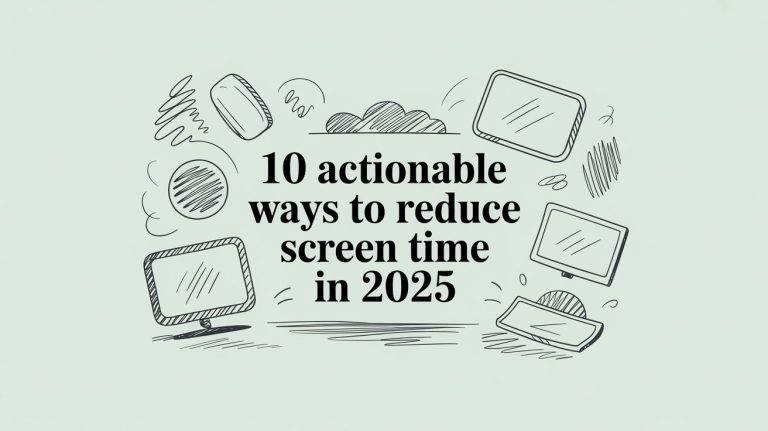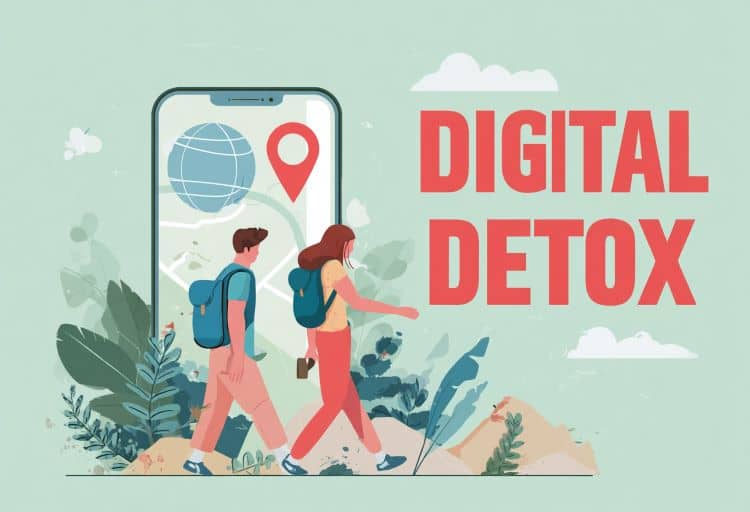Your 7-Day Digital Detox Challenge
Ever feel like you’re drowning in a sea of notifications? That little ping, that constant buzz, that phantom vibration in your pocket—it’s the soundtrack of modern life. If you’re feeling permanently “on,” you’re not alone.
That feeling of digital overload is why a digital detox challenge has gone from a fringe wellness trend to an essential tool for mental clarity. This isn’t about ditching your phone forever. Think of it as hitting a reset button. This 7-day plan is a manageable, empowering way to take back control, assess your relationship with your devices, and break the cycle of mindless scrolling.

Why a Digital Detox Is No Longer Optional
The need for a break often sneaks up on us until it feels urgent. As our screen time creeps up, so do the side effects. It’s a widespread issue, with a staggering 61% of people admitting they feel addicted to the internet and their screens. This highlights a critical dynamic: we’ve lost agency over our own attention.
The core implication is a shift from intentional use to reactive consumption. A digital detox directly confronts this. It’s about moving from being a passive user, pulled in every direction by algorithms, to an intentional one where you dictate the terms of your engagement. This deliberate step back helps you pinpoint your triggers and start building healthier habits.
A Breakdown of the Benefits
The payoff is significant and can be felt almost immediately. Here’s a breakdown of what you stand to gain, comparing the “before” and “after” state.
| Benefit Area | Before Detox (The Problem) | After Detox (The Solution) |
|---|---|---|
| Mental Health | Constant comparison and a 24/7 news cycle fuel anxiety and feelings of inadequacy (FOMO). | Stepping away reduces anxiety and replaces the Fear of Missing Out with the Joy of Missing Out (JOMO). |
| Cognitive Focus | A barrage of notifications shatters concentration, leading to shallow, fragmented thinking. | Without interruptions, your brain can engage in deep work, improving problem-solving and creativity. |
| Sleep Quality | Blue light from screens before bed disrupts melatonin production, leading to poor, unrefreshing sleep. | Disconnecting in the evening allows your natural sleep cycle to recover, resulting in more restorative rest. |
| Social Connections | Digital interactions often replace genuine, face-to-face engagement, weakening real-world bonds. | Unplugging encourages direct, meaningful interactions, strengthening relationships beyond a simple “like” or “share.” |
If any of the “before” states sound familiar, it’s a clear sign. Check out these 7 signs you need a digital detox to assess your own habits.
How to Prepare for a Successful Detox
Jumping into a digital detox cold is a recipe for failure. Your success won’t come down to sheer willpower; it’s all about smart preparation. Think of it as clearing the path ahead of time so the journey itself is as smooth as possible.
The first, and most important, step is managing expectations—for yourself and for others. Give friends, family, and key colleagues a heads-up that you’ll be less available. A quick text or email is all it takes to prevent them from worrying and to dial down the social pressure to be constantly online. For work, an auto-responder is non-negotiable.
A simple “out of office” reply does the trick. Something like, “Thanks for your message! I’m on a digital detox to recharge and will get back to you when I return. For anything urgent, please contact…” It’s professional and sets a firm, clear boundary from the get-go.
This initial prep work is crucial. Before you even think about turning off your devices, you need a solid game plan. The steps below will help you iron out the details, minimizing friction and setting you up for a much more rewarding experience.
Your Pre-Detox Action Plan
Follow these essential steps before day one of your digital detox challenge to minimize friction and maximize your chances of success.
| Preparation Step | Why It Matters | Your Action Item |
|---|---|---|
| App Audit & Deletion | Removing the biggest temptations is the easiest win. Out of sight, out of mind. | Take 30 minutes to delete unused apps and, most importantly, the social media apps you’ll be avoiding. |
| Notify Your Circle | This prevents unnecessary worry and reduces the social pressure to respond. | Send a quick text or email to close friends, family, and key work contacts about your detox. |
| Set Up Auto-Responders | This creates a professional boundary and manages expectations for work communication. | Craft a simple “out of office” message for your work email and any relevant messaging apps. |
| Brainstorm Offline Fun | Having a list of appealing activities prevents you from defaulting to your phone out of boredom. | Make a physical list of at least 10 non-digital activities you genuinely enjoy (reading, hiking, a project, etc.). |
| Create Tech-Free Zones | Designating physical screen-free areas makes it much easier to stick to your goals. | Decide on at least one tech-free zone. The bedroom is the best place to start for better sleep. |
| Get an Analog Alarm | If you rely on your phone’s alarm, you need a replacement to avoid temptation first thing in the morning. | Buy a simple, old-school alarm clock and set it up in your bedroom. |
Taking the time to check off these items transforms your detox from a vague idea into a concrete plan. It’s the difference between hoping for success and engineering it.
Audit and Curate Your Digital Space
Before you pull the plug, you need to know what’s pulling you in. Carve out 30 minutes for a ruthless app audit on your phone. Just scroll through your screens and ask one question for each app: “Does this genuinely add value to my life, or is it just a time sink?”
Be brutally honest. If you can’t remember the last time you opened an app, just delete it. For the big ones—the social media apps that are likely the reason you’re doing this challenge—getting them off your phone is the single most effective move you can make. That tiny bit of friction is often enough to stop the mindless, automatic tap that happens the second boredom strikes.
This isn’t just about cleaning house; it’s about proactively removing the primary sources of temptation so your detox environment is easier to navigate.
Brainstorm Compelling Offline Alternatives
One of the most common pitfalls I see is people not knowing what to do with all their newfound free time. That void left by endless scrolling can feel surprisingly jarring. You absolutely need a list of compelling, non-digital activities to fill it.
This isn’t just about finding distractions. It’s about reconnecting with fulfilling, real-world experiences that actually make you feel good. Your goal is to make these offline options more appealing than grabbing your phone.
Need some ideas to get the ball rolling?
- Get Creative: Pick up that sketchbook you bought ages ago, write in a journal, or finally tackle that new recipe.
- Get Moving: Go for a long walk—without headphones. Do some stretching. Just visit a local park and sit on a bench.
- Engage Your Mind: Read a physical book, listen to a full album on a record player, or tackle that junk drawer that’s been bothering you.
- Connect with People: Plan a coffee date with a friend (with a no-phones pact!) or break out a board game with your family.
Having a go-to list ready makes it infinitely easier to resist the magnetic pull of your devices when you feel restless.
Create Tech-Free Zones
Finally, you need to designate physical areas in your home as tech-free zones. The most powerful and impactful place to start is your bedroom. The science is clear: studies show again and again that the blue light from our screens messes with melatonin production, wrecking our sleep quality.
By making your bedroom a sanctuary from screens, you’re not just fighting temptation—you’re directly improving your physical and mental health. Charge your phone in the living room or kitchen overnight. If you use it as an alarm, buy a cheap alarm clock. Seriously. This one change can have a massive ripple effect, improving your rest and setting a positive tone for your entire detox.
The Day-by-Day Digital Detox Challenge Plan
Alright, this is where the rubber meets the road—and where you’ll start to feel the real magic happen. This seven-day plan is designed to gently ease you into a more mindful relationship with your tech. We’re not going for a shock to the system here.
Each day builds on the last, introducing a new theme and a slightly deeper level of disconnection. This gradual approach makes the whole challenge feel achievable instead of like you’re about to climb Everest in your slippers. We’ll start with small tweaks and build momentum from there. For each day, you’ll find a clear morning intention, a few specific rules for your tech use, and ideas for offline activities to fill that new space you’re creating.
Before we dive in, this simple visual lays out the prep work that makes the daily plan stick. It’s all about telling people you’re unplugging, getting those tempting apps off your phone, and having a few real-world activities lined up.

A successful detox isn’t just about raw willpower; it’s about setting up your environment for success before you even begin.
Day 1: Notification Neutralization
Morning Intention: Today, I will control my phone’s interruptions instead of letting them control me.
Your first day is all about reclaiming your focus by silencing the constant noise. Dive into your phone’s settings and turn off all non-essential notifications. I’m talking about the alerts from social media, news apps, shopping sites, and games. Be ruthless.
The only things that should be allowed to buzz you are actual phone calls or messages from a few key people. Everything else can wait.
Offline Idea: Go for a 20-minute walk and leave your phone behind. Seriously. Notice the sounds and sights you usually miss when your head is down.
Day 2: The Social Media Fast
Morning Intention: Today, I will connect with my immediate surroundings, not a digital feed.
Building on yesterday, Day 2 is a full 24-hour break from all social media. That means no Instagram, TikTok, Facebook, X (formerly Twitter), or even LinkedIn. If you deleted the apps during your prep, you’re already ahead of the game. If not, log out of everything on every device.
You might feel a little twitchy at first. That vague sense of unease or FOMO (fear of missing out) is totally normal, but I promise it fades. Just notice how many times your thumb instinctively goes looking for an icon that isn’t there.
The goal isn’t to demonize social media. It’s about breaking the cycle of compulsive, automatic checking. Creating this space lets you re-engage later on your own terms.
Offline Idea: Pick up a physical book or magazine you’ve been meaning to read. See if you can get lost in it for at least 30 minutes straight, no interruptions.
Day 3: Mindful Media Consumption
Morning Intention: Today, I will consume information with purpose, not out of habit.
Today’s mission is to be deliberate about what you watch and read. Instead of mindlessly scrolling through news feeds or letting Netflix autoplay the next episode, you get to be the boss.
Limit your news to one or two specific times during the day, and get it from a source you trust. For entertainment, pick a movie or a show before you even turn on the TV, rather than getting sucked into the endless browse. This simple shift helps fight the mental fatigue that comes from the firehose of content we’re usually blasted with.
Day 4: The No-Phone Evening
Morning Intention: Today, I will create a peaceful evening free from screen-based distractions.
Here’s a big one: put your phone away for the entire evening. Set a cutoff time—say, 7 PM—and don’t touch it again until tomorrow morning. This is one of the most powerful things you can do to improve your sleep and be more present with the people around you.
If a full week feels like too much right now, remember that even a shorter, focused break can make a huge difference. For a more condensed version of this, our weekend digital detox step-by-step checklist is a great place to start.
Offline Idea: Cook a meal from scratch. The physical, sensory experience of chopping, stirring, and smelling is a fantastic way to ground yourself in the here and now.
Day 5: Deep Work and Focus
Morning Intention: Today, I will dedicate my full attention to a single, meaningful task.
Embrace the lost art of single-tasking. Choose one important thing—a work project, a personal passion, organizing that junk drawer—and give it a solid, uninterrupted block of your time.
Put your phone in another room. Close all the extra browser tabs. Give your brain the runway it needs to really take off. You’ll be floored by what you can accomplish without the constant pings and context-switching.
Day 6: Analog Adventures
Morning Intention: Today, I will find joy and adventure in the physical world around me.
Time to be brave. Leave your phone at home for an extended period and go do something. Visit a park, a museum, or just explore a part of your town you’ve never really seen.
Rely on your own senses and maybe an old-fashioned paper map. This day is about rediscovering the world without a screen mediating the experience for you.
Day 7: Reflection and Reintegration
Morning Intention: Today, I will reflect on my experience and set intentions for a healthier digital future.
The final day isn’t about staying disconnected; it’s about reconnecting mindfully. Take some time with a journal and think about your week. What did you notice? What was hard? What felt surprisingly good?
As you start to bring technology back in, do it with the lessons you’ve learned. Set new boundaries. This isn’t just a feel-good exercise; it’s critical for our well-being. Research shows that 57% of millennials report that taking tech breaks significantly reduces their anxiety and stress. This is about building a better, more balanced life going forward.
Tailoring the Challenge to Your Real Life
A rigid, one-size-fits-all digital detox is a recipe for failure. The secret to a successful reset is adapting the core principles to your unique life, not trying to force your life into a strict set of rules. The goal here is sustainability, not perfection.
Let’s be realistic: completely disconnecting is a non-starter for many of us. If you’re a remote worker, a parent, or have urgent family responsibilities, you need a more flexible game plan. Here’s a breakdown of different approaches and who they’re for.
The Detox Lite vs. The Hardcore Detox: A Comparison
| Approach | Detox Lite (Digital Dieting) | Hardcore Detox (Full Unplug) |
|---|---|---|
| Who It’s For | Busy professionals, parents, those new to detoxing who need to stay connected. | Individuals on vacation or a long weekend, or those feeling completely burned out and needing a deep reset. |
| Core Principle | Create firm, strategic boundaries around tech use (e.g., no phones during meals, email cut-offs). | Complete disconnection from all non-essential digital devices for a set period (e.g., 48-72 hours). |
| Primary Goal | Reclaim pockets of time and mental space within a connected lifestyle. | Remove the entire mental load of being “online” to allow for deep rest and self-reflection. |
| Key Implication | Promotes sustainable, long-term habit changes without disrupting essential responsibilities. | Provides a powerful, restorative shock to the system that makes old habits easier to break upon return. |
For a deep dive into the hardcore approach, our two-day digital detox your how-to checklist is the perfect resource. The “Detox Lite,” meanwhile, focuses on actionable boundaries like no screens during meals and dedicated single-tasking work blocks.
Adapting the Challenge for Families
When you’re a parent, a digital detox is almost always a family affair. The goal is to get everyone’s screen time down and encourage more face-to-face, offline activities.
- Establish a Family “Device Box”: During dinner or family game night, everyone’s phone goes into a designated box. No exceptions.
- Lead by Example: Your kids will buy in a lot faster if they see you genuinely committing to less screen time yourself.
- Plan Analog Fun: Get some offline activities on the calendar. Think a hike, a board game tournament, or even just a collaborative cooking project.
Recent consumer digital detox trends on gwi.com reveal this dynamic clearly. Millennials aged 25-34 are leading the charge on full detoxes, often to escape professional burnout, while others prefer the more flexible “digital dieting” approach. Understanding these differences helps you choose the path that best fits your own life.
Overcoming Common Digital Detox Obstacles
Embarking on a digital detox is a fantastic step, but let’s be real—it’s rarely a smooth ride. Unplugging is genuinely tough in our hyperconnected world, so you should expect to hit a few bumps. The real key to success isn’t avoiding obstacles, but knowing what they are and having a game plan before they show up.
One of the first and most powerful hurdles you’ll likely face is the intense fear of missing out (FOMO). The second you disconnect, your brain might start screaming about what you’re not seeing on social media or in your group chats. This feeling is a deeply conditioned response, not a reflection of reality.
The best way to fight back is to completely reframe the situation.
Instead of fearing what you’re missing, focus on what you’re gaining. This isn’t FOMO; it’s JOMO—the Joy of Missing Out. You are actively choosing to be present in your own life instead of just passively watching everyone else’s.
This simple mindset shift is your most powerful tool. It transforms a feeling of being deprived into one of empowerment and deliberate choice.
Tackling Sudden Boredom and Anxiety
Another challenge that surprises a lot of people is a sudden, almost uncomfortable sense of boredom. After years of filling every spare second with scrolling, an empty moment can feel jarring, even stressful. Your first instinct will probably be to grab your phone, but this is the exact moment where the real magic happens.
Instead of seeing boredom as a void you need to fill, try viewing it as an opportunity. This is your brain’s chance to finally rest, wander, and get creative without constant input.
- Have a Go-To List: Remember that list of offline activities you made? Keep it somewhere you can see it. When boredom strikes, just pick one—anything—and commit to doing it for just 10 minutes.
- Embrace Stillness: Try simply sitting without any distractions at all. Pay attention to your surroundings, the sounds, the light. This simple act of mindfulness can be incredibly calming and helps retrain your brain to not need constant stimulation.
Navigating Social Pressure
Finally, you might run into some social friction. Friends or family who don’t quite get what you’re doing might get annoyed that you didn’t instantly reply to a message or question why you’re suddenly “unreachable.”
Communicating your boundaries clearly and confidently is absolutely essential here. You don’t need to apologize for prioritizing your mental well-being. A simple, firm explanation is usually all it takes to smooth things over.
For instance, you could say something like: “Hey, just a heads-up, I’m doing a short digital detox this week to recharge, so I’ll be slower to respond. It’s nothing personal—I’m just trying to be more present!” This kind of proactive communication sets expectations, normalizes what you’re doing, and gives you the space you need to actually succeed.
How to Reintegrate Tech Without Losing Your Progress
So you made it through the detox. Congratulations! But the end of the challenge isn’t a finish line—it’s actually the starting line for a more intentional relationship with your devices.
The goal was never to abandon technology forever. It was about reclaiming control. The biggest mistake is to rush back to your old habits, which will undo all your hard-earned progress in a single day.
The key is mindful reintegration. Before you dive back in, take a quiet moment to reflect on what you actually learned during your break. Did you feel calmer? More focused? Did you sleep better? These positive feelings are your new benchmark for what a balanced life can feel like.

Building Your New Digital Framework
Your first move is to turn those insights from your detox into a sustainable, real-world plan. Start by auditing the apps you plan to reinstall. Be absolutely ruthless here.
If an app didn’t genuinely improve your life before the detox, it doesn’t deserve a place on your home screen now. This is your chance to curate a digital environment that actually serves you, not the other way around.
Next, you need to establish some clear, non-negotiable boundaries. These are the new rules of engagement that will protect your newfound peace and focus for the long haul.
- Schedule Screen-Free Time: Make “unplugged” a regular part of your calendar. This could be something like a tech-free Sunday morning or a strict no-phone-in-the-evening rule after 8 PM.
- Curate Your Feeds: Get in there and unfollow accounts that trigger anxiety or comparison. Mute those group chats that are more noise than value. You are now the bouncer of your own digital club.
- One Screen at a Time: Make a commitment to ending the habit of “second screening.” If you’re watching a movie with someone, put your phone in another room. Be fully present.
This transition is all about moving from a reactive to a proactive relationship with technology. You are now the gatekeeper of your own attention, deciding what gets in and what stays out.
Using Tech to Manage Tech
Ironically, some of the best tools for maintaining this new digital balance are apps specifically designed to monitor your usage. It might feel counterintuitive, but setting firm screen time limits for certain apps can give you a helpful nudge when you start slipping back into old patterns of mindless scrolling.
Ultimately, this whole reintegration process is an ongoing experiment. Some boundaries will stick easily, while others might need a bit of adjusting as you go.
The true success of your digital detox challenge isn’t measured by the seven days you spent offline. It’s measured by the lasting, positive changes you bring back into your daily, connected life.
Ready to build sustainable habits and maintain your digital balance? The Digital Detox App provides a suite of free, simple tools designed to help you create a healthier relationship with technology. Start reclaiming your attention today at https://digitaldetoxapp.com.





